- Offensive Techniques & Strategies
Hawk Offense
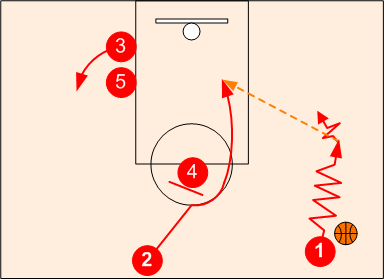
What to Discover or Recall . . .
The Hawk Offense is a relative of the "UCLA" high post rub offense and a derivative of the shuffle offense.
The Hawk Offense has proven to be a very successful offense on all levels of the game.
Although the Hawk Offense is primarily designed to take advantage of a mismatch at the off guard or shooting guard position, it also includes wing isolations and strong post up options.Introduced into the NBA by Hubie Brown when he was coaching in Atlanta, thus its name. The basic option of the Hawk offense is the off guard's rub cut off a high post screen. The point guard initiates the action with dribble penetration entry to the wing as the high post sets a back screen for the off guard. When a good shot is not available, the Hawk Offense provides for a quick reversal and down screen action on the weakside.
| Wing Iso | Shuffle Cut | Ball Reversal | Continuities | Variations | Game Strategy | Case for Defense |
Schematic Sequence

Offensive Fundamentals Required
 Creating Leads - Proven Techniques to Get Open
Creating Leads - Proven Techniques to Get Open

Basic Hawk Action
Phase 1. Dribble Entry (Point Isolation)
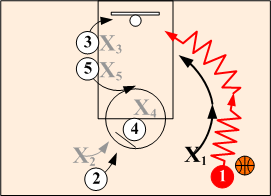
Read: Ball handler is able to BEAT DEFENDER
The point guard, isolated One-on-One, has the option of turning the corner for a drive to the basket whenever they feel that they can beat their defender.
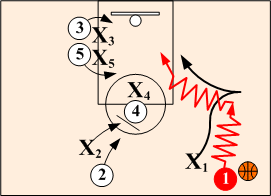
Middle Drive. When the defender cuts off the baseline dribble penetration, O1 can make a cross over or spin move and drive inside to the basket.
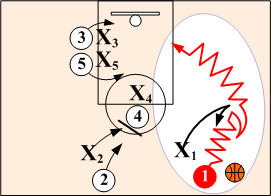
Fake Spin. The point can fake turning back and drive hard to the basket.
Read: Weakside defender SAGS OFF to help on drive.
Whenever the point turns the corner and drives O3 and O5 move into drop zone positions.
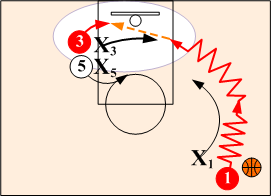
Base drop. When the weakside defender X3 sags off to help out on O1's drive, O1 passes to O3 on baseline. Point also has option of pulling up for short bank shot.
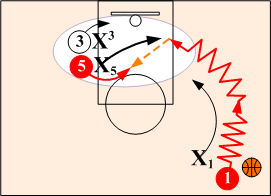
Post Drop. If weakside defender X5 sags off to help out on O1's drive, O1 makes a drop pass to O5. If defender X3 should step up and deny the pass to O5, then O1 makes a drop pass to O3 on baseline.
Read: Defense DOUBLE TEAMS Ball Handler
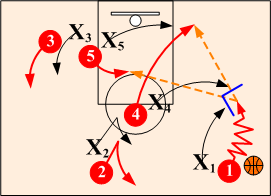
Weakside Flash to Middle. When defender X4 steps out and double teams the ball handler O1 early. Cutter O2 bumps back and O4 rolls to baseline. O1 looks to pass to O5 flashing into the middle or to O4 rolling out to the short corner.
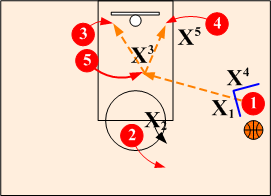
Flash. When O1 passes to O5 flashing into the middle, O5 has options of shooting or making a drop pass to O3 or O2 if defender challenges O5's shot.
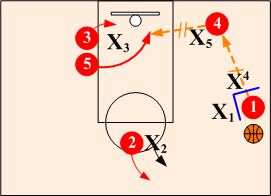
Short Corner. If O1 passes to O4 in short corner, O4can shoot or feed O5 rolling to the basket. If defender X3 sags off to help out, O5 can make a drop pass to O3.
Note: If O2 has already rubbed off high post, O4 pops out and O2 goes to short corner.

Phase 2. High Post Shuffle Cut
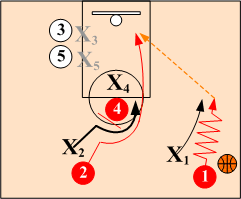
When the ball handler penetrates to wing, off guard O2 walks the defender X2 into O4's high post back screen and cuts to basket. Point guard O1 looks to feed O2 making a basket cut off O4's high post screen or posting up against a smaller or weaker defender. Should the defender get hung up on O4's high post screen or trail O2 it will certainly result in an easy lay up.
The keys to the success of the Hawk's high post rub cut is execution and coordination. The cutter, screener and the passer have to think and function as one unit. This requires defensive recognition, timing, and non-verbal communication. Players should be prepared to recognize and attack the following situations:
Shuffle Cut Reads: What if the defense. . . .
The defender CHASES OVER the screen
The defender GOES UNDER the screen
The defenders SHOW & RECOVER on the screen
The defenders SWITCH on against the screen
The defenders ANTICIPATE and ZONE against the screen
The defenders DOUBLE TEAM against the screen
1. Read: Defensive player CHASES OVER the screen.
Counter: Hard Basket Cut

Top Cut: Off guard O2 walks the defender X2 into O4's high post screen. When the defender X2 assumes an inside position and chases O2 over the high post screen, O2 makes a direct cut to the basket looking for a pass from O1 for layup. O2 also has the option of posting up against X2.
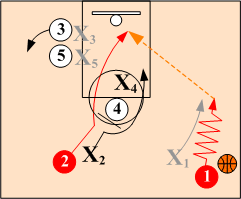
Under Cut: When the defender X2 assumes an outside defensive position, O2 cuts under the screen looking for a pass from O1 for layup. O2 also has the option of posting up against X2.
2. Read: Defensive player CHASES UNDER the screen.
Counter: Bump Back
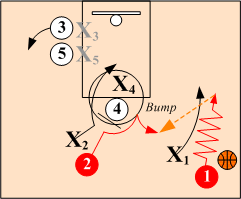
When the defender X2 cheats and goes under O4's high post screen, O2 pops (bumps) back out for open jump shot.
3. Read: Defense SWITCHES on high post rub cut.
Counter: Post Roll Option
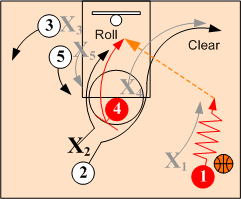
Post Roll. On defensive switch, O2 clears to corner as point looks to feed O4 rolling to basket against smaller defender X2.
Post Isolation
Read: Defense SWITCHES on high post rub cut.
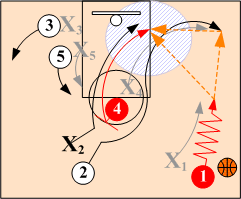
Roll & Post Up. On defensive switch, when a smaller defender is "MISMATCHED INSIDE" against the screener O4, O2 clears immediately to the corner and screen O4 rolls to the basket and posts up. O1 or O3 looks to feed O4 posting up.
Corner Isolation Option
Read: Defense SWITCHES on high post rub cut.
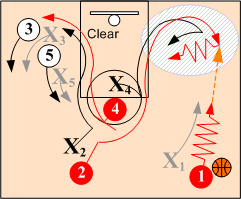
Corner Isolation. On the defensive switch, when a bigger defender is "MISMATCHED OUTSIDE" against the cutter O2, screener O4 clears out to the weakside isolating O2 against X4.
4. Read: Defenders ANTICIPATE SWITCH (ZONE)
Counter: Slip Option
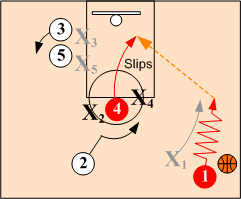
When defenders X2 and X4 anticipate and zone against O2's high post rub, O4 fakes the screen and slips the screen and cuts to the basket. O1 looks for O4 cutting away to basket.
5. Read: Defenders SHOW & RECOVER on rub cut.
Counter: Break Off Screen & Cut Away
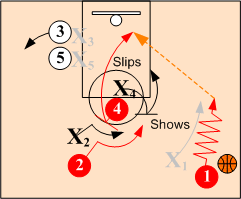
When defender X4 steps out to show (block) on O2's high post rub cut, O2 takes X4 wide as screener O4 breaks off the screen and cuts to the basket. O1 looks for O4 cutting away to basket.
6. Read: Defense DOUBLE TEAMS off-guards post up.
Counter: Drop or Kick Out Pass
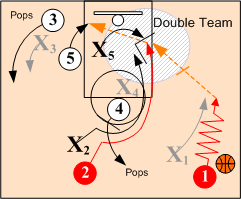
Drop Pass. When defender X5 doubles teams O2 in post area, O2 looks to make a drop pass to O5. O1 also has option of making a skip pass across to O3 who can feed O5.
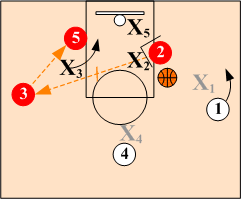
Kick Out Pass. When defender X3 drops down and assumes a defensive position against O5, O2 has option of making a kick out pass to open O3 for spot up shot. If defender X3 should rotate back out to O3, O3 can feed O5 in low post.
7. Read: Defenders DOUBLE TEAM post up EARLY
Counter: Ball Reversal
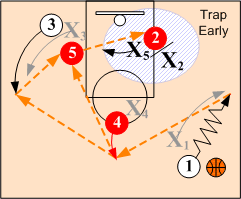
When defender X5 double teams cutter O2 early, O1 makes a reversal pass out to screener O4. O4 looks to feed open O5 directly or if defender X3 drops down to help out passes to O3 who in turn can feed O5. If defender X5 recovers back to O5, O5 can make a drop pass to O2.

Phase 3. Ball Reversal Down Screen
If O1 cannot feed O2 inside, O1 then looks to make a reversal pass out to O4 stepping out to initiate weakside, post isolation action.
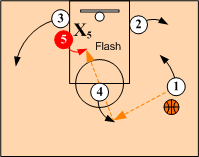
Post Flash. On O1's reversal pass to O4, O3 pops out and O5 flashes into middle looking for a Hi/Lo feed from O4. O2 clears to corner. O4 looks to feed O5 on Hi/Lo post pass.
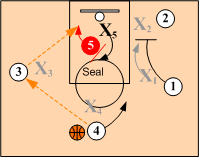
Low Post Iso. If defender X5 denies the Hi/Lo pass to O5, O4 passes to O3 popping out to wing. O5 seals off defender X5 and rolls to the basket for feed from O3.
 Setting and Using Down Screens
Setting and Using Down Screens Counters vs. Post Defensive Overplay
Should the defense try to disrupt ball reversal by overplaying and denying the passing lane to the high post, the high post has the options of cutting to the basket or exchanging positions with O5 by setting a down screen.
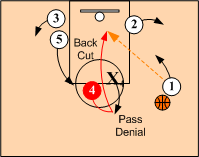
Back Cut Overplay Counter
If X4 overplays the passing lane to O4, O4 back cuts to the basket for shot. O5 pops out exchanging positions with O4.
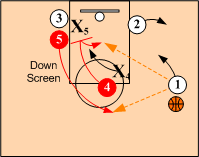
Defensive Overplay: Post Exchange
Down Screen. When defender X4 denies the pass to O4, O4 also has option of setting a down screen for O5. If the defense switches O1 looks to feed O4 inside.

Continuity
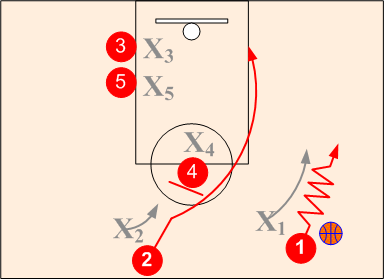
When the Hawk's basic action does not produce a good shot, most teams will flow into a motion or side screen continuity as the shot clock winds down. Flowing directly into an organized continuity prevents any panic or rushed shots as the shot clock winds down while allowing for the ball to get into the player's hands you want to have handling the ball and taking the shots at the end. Continuity also maintains court balance with good offensive rebounding position and 2nd efforts to take place.
Continuities: | Flex | Triangle Game | Motion |
Flex
The Flex continuity is a powerful screening game utilizing strong baseline and down screens. The continuous "Pick the Picker" screening action puts a tremendous burden on the defense by having to defend two different types of screens simultaneously. Teams that exhibit good patience will surely create open shots. The Flex continuity also provides strong offensive rebounding and second efforts by constantly having two rebounders on the weakside.
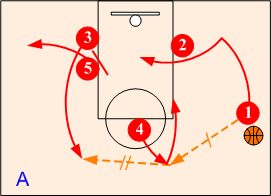
Ballhandler O1 strings out the defense with dribble as O5 clears to corner. O1 looks to pass to O2 rubbing off O4's base screen. O3 sets a down screen for O4 and then clears to corner.
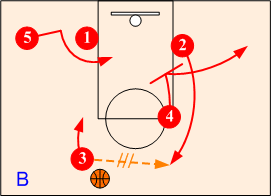
Flex's "Pick the Picker" action continues with O1 passing to O4 popping out. O5 comes off O2's baseline screen and O1 down screens for O2.
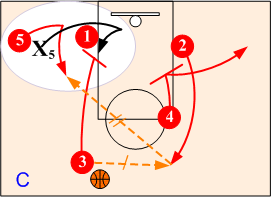
Bump: If O5's defensive player X5 anticipates the baseline cut and cheats below post screen, O5 starts the baseline cut, but bumps back off O1's and O3's double screen for shot.
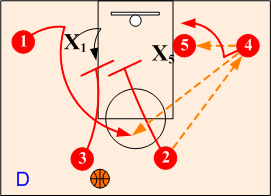
Corner Pass: When the ball is passed to corner, O2 can either screen across for O3 or set a double screen with O3 for O1. O4 looks to feed O5 posting up strong or pass to O1 coming off the double screen.
Triangle Game
The inside Triangle Game continuity is a powerful inside game with wing shooters. Since a lot of inside screening takes place, it is best run with physically strong players. The inside players should be good, but do not have to be dominating, since most of their shots will come off screens. Players must be well schooled in the fundamentals of setting and using screens. Placing good shooters on the wings will spread the defense, allowing the inside screening game to take place. A smaller player can be deployed inside to create mismatches if so desired.
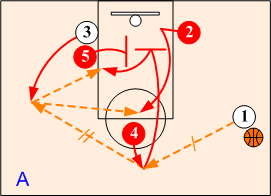
To initiate the Triangle Game action O1 passes out to O4 who in turns passes to O3. O4 sets a down screen for O2 and then breaks off O5's baseline screen.
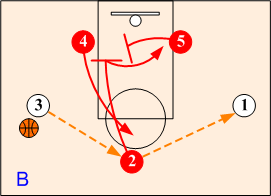
Down Screen: When the ball is reversed or skip pass across to O1, O2 screens down for O4, and O5 sets a base screen for O2.
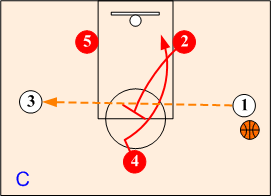
Back Screen Option: O2 has option of setting a back screen for point O4. Wing O3 looks to make a lob pass to O4 back cutting to the basket or feeding O5 posting
up.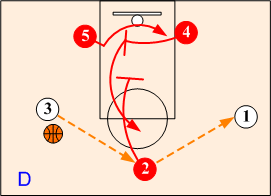
Base Screen Option: When the ball is reversed or skip pass across to O1, O4 screens across for O5, and then breaks out off of O2's down screen.
Motion (Passing Game)
The motion or passing game continuity with its five player continuous movement, opens up the middle for penetration and cuts. The passing game allows for a lot on individual offensive freedom. Since there is no precise structure, player movement is very unpredictable and difficult to defend. The passing game takes advantage of sagging type defense. Most of the shots will be face up, medium range created by setting down and base screens. With the middle is purposely kept open for drives and cuts to the basket, any posting up that does occur is usually comes after a player sets a screen. Since shooters will most often receive the ball going away from the basket, offensive rebounding can be a problem.
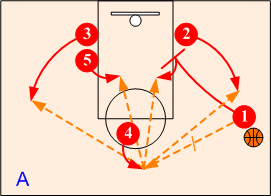
Down Screen: When the ball is passed out to the point, O1 and O5 set down screens for O2 and O3 on baseline. Ball handler O1 has option of feeding O2 or O3 coming off the down screens or O1 and O5 posting up strong inside.
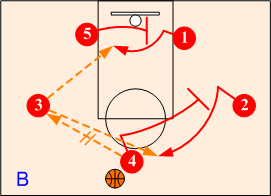
Screen Away: Anytime the ball is passed to a wing, it initiates screen away action. O4 and O5 screen away for O1 and O2.
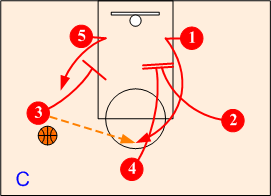
Double Screen Option: When the ball is passed out to a wing, the opposite wing has the option to screen down with the point creating a double screen. Ballhandler O3 has option of feeding O5 posting up or O1coming off the double screen.
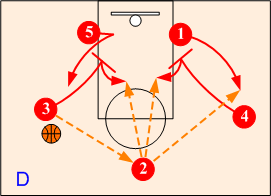
Down Screen: When the ball is passes out to O1, the down screen action continues.

Hawk Offense: Variations
Various NBA teams have adapted the Hawk's basic off guard cut to take advantage of their specific player personnel. Most of these variations are actually secondary options off the shooting guard's high post rub cut. Some of these more frequently used Hawk variations used in the NBA include:
| Side Screen | Single Double | Post Back Screen | Pin Down | Base Screen | Post Lob |
Side Screen
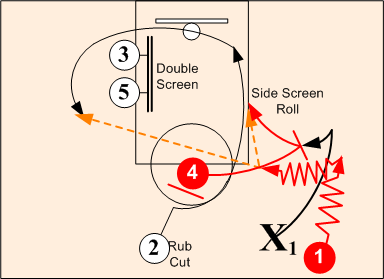
Side screen is the most popular variation of the basic Hawk Offense. This two person game is a quick hitter with the high post O4 stepping out to the wing after O2's rub cut to initiate screen roll action with the ballhander O1. The off guard O2, after making the high post rub, will continue out weakside off O3's and O5's double screen.
Single/Double
The Single/Double passing game maintains focus on getting the ball to the off guard especially when the off guard is a great outside shooter. The ball handler O1 makes a reversal pass out to the high post stepping out at the top of circle and then sets a down screen for O2. The off guard has the option of continuing out to the weakside off O3's and O5's double screen or doubling back off O1's screen. The small forward goes opposite O2.
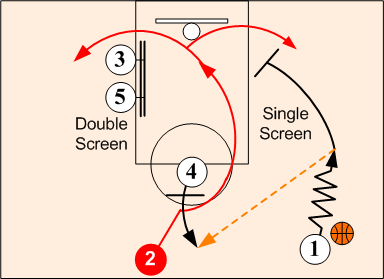
Single/Double. O1 passes to O4 and sets a down screen. O2 has option of going off O3's and O5's double screen or O1's single screen.
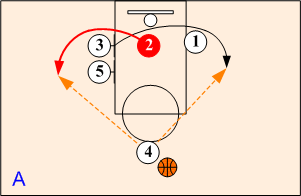
Double Option. When O2 goes off the double screen, O3 goes opposite off O1's screen.
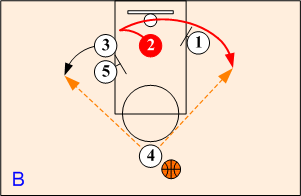
Single Option. O2 opts to go off O1's screen, O3 pops out opposite off of O5's screen.
Back Screen
The Back Screen variation is unique because the high post screens for the off guard, and then the off guard loops back up and sets a back screen for the high post. This then allows the high post and off guard to exchange positions for ball reversal options. The Back Screen along with the Pin Down is mainly used when the high post is not an outside shooter or as a change of pace.
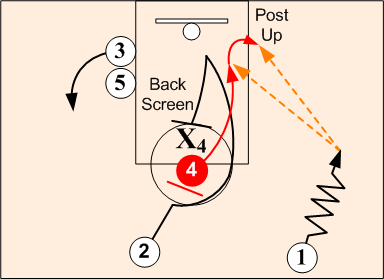
Back Screen. After rubbing off high post O4, cutter O2 sets a back screen for O4. Screener O4rolls to the basket looking for feed from O1.
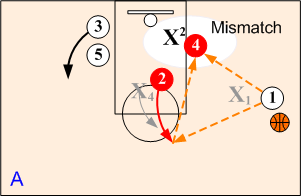
Post Up: If the defense should switch, O4 posts up hard against the smaller defender X2.
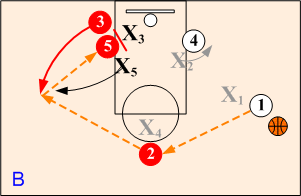
Ball Reversal:Ballhandler O1 makes a reversal pass out to O2 who in turn looks for O3 coming off O5's screen. If the defense should switch O3 looks to feed O5 posting up against smaller O3.
Pin Down
The Pin Down variation allows for a high post and shooting guard exchange. After the shooting guard makes the rub cut, the high post O4 rolls down and sets a down screen for O2. Ballhandler O1 looks to feed the high post O4 posting up or the shooting off guard popping out off O4's down screen. The pin down can be an effective option when the high post is not a great outside shooter.
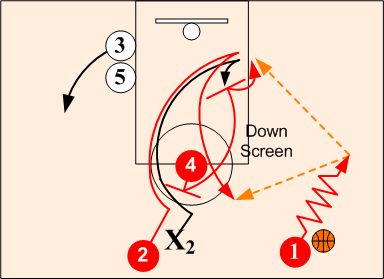
Pin Down (Down Screen): After rubbing off high post O4 sets a down screen for O2. Screener O4 rolls to the basket looking for feed from O1.
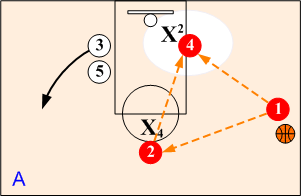
Post Up: If the defense should switch, O4 posts up hard against the smaller defender X2.
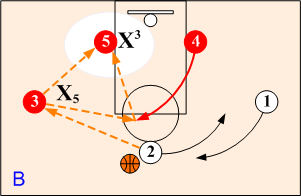
Ball Reversal: O2 makes a reversal pass to O3 who in turn looks to feed O5 posting up against smaller X3. O4 breaks high for a High/Low feed.
Base Screen
Posting up is a big part of the game of basketball. It is truly an advantage to have a dominant force inside. However, post ups are not limited to just big men, look for all teams to exploit size mismatches at any position. In addition, teams will commonly deploy the tactic of a small player setting a screen for a big player to create mismatches such is the case with the base screen variation.
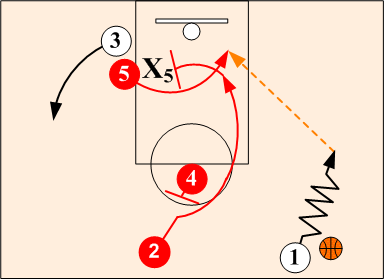
Base Screen. 02 after making the high post rub cut sets a baseline screen (small screening for big) under the basket for the post O5. O5 comes off O3's screen for a shot or a strong post up.
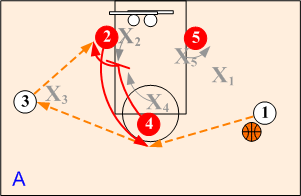
Ball Reversal: O4 sets a down screen for O2. Ballhandler O1 makes a reversal pass to O2 who in turn passes to O3. O3 looks to feed O4 posting up strong.
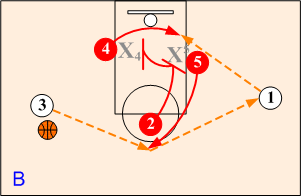
Continuity: O2 after passing to O3 sets a down screen for O5. O3 makes a cross court pass to O1 or passes to O5 who in turn passes to O1. O2 sets a baseline screen for O4.
Post Lob
The lob pass is a very effective variation when the defenders overplays the reversal pass to the high post.
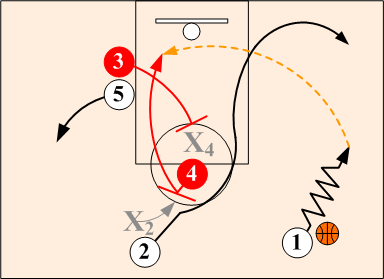
Lob: If O2 is not open on rub cut, O2 clears to corner. O5 steps out weakside and O3 steps up and sets a back screen for O4. O1 looks to lob to O4 rolling to basket.
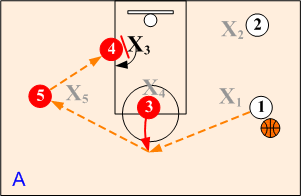
Post Up: If the defense switches or O1 is unable to lob to O4, O1 passes to O3 who looks to feed O4 posting up smaller defender X2 or to pass to O5 for a post feed from the wing.
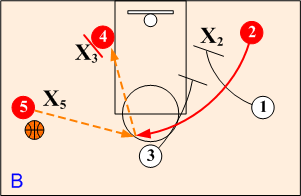
Ball Reversal: When O5 is unable to feed O4 in low post area, O5 initiates motion action by passing out to O2 coming off O1's and O3's double down screens. O2 looks to shoot or to pass to O4 if fronted by defender X3.

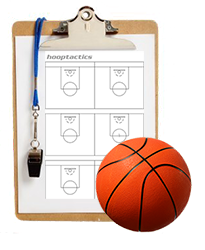
Teaching & Implementing the Hawk Offense
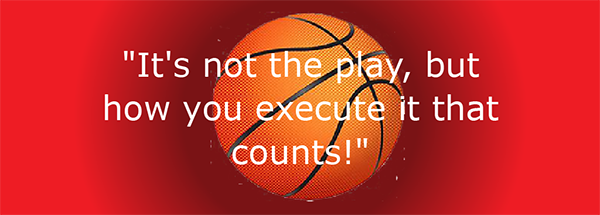
The key to the success of the Hawk Offense is in its spacing, execution and coordination. Players need to be well prepared to execute high post rubs, down screens along with strong post ups. The ballhandler, screener and receiver must think and function as one unit. This requires non-verbal communication, timing, and, most of all, defensive recognition.
Caution: Before undertaking any offense, players must have a solid, working knowledge of all of its components.
Breakdown Drills:
 2-on-2 Combination Down Screen, Post Ups and Side Screen
2-on-2 Combination Down Screen, Post Ups and Side Screen 3-on-3 Combination Drill (HP Rub, Down Screen & Side Screen Action)
3-on-3 Combination Drill (HP Rub, Down Screen & Side Screen Action)The Game Within a Game
Individual offensive skill development and improvement should be an integral part of every practice. In addition to early time (before practice) work, each player should, personally, have one or two individual fundamental techniques to work on during the course of a practice. The specific skill or skills will vary from player to player and can be assigned by the coaching staff or determined by the players themselves. As a reminder, the skill(s) should be written down on a 3 X 5 card and give it to each player prior to practice.

Game Strategies
Scout your opponent. Players need to know what reads to expect during the game. Opponents will generally use only a primary and secondary defense technique in defending side screens. Educate and explain the anticipated reads and their counters. When scouting is not possible, scout your opponent during the game.
Don't be a spectator and watch the ball during the game. Be conscience and alert to any defensive changes or adjustments, especially after substitutions and timeouts. Don't hesitate in deploying various alignments and entries during the game so that defenders cannot focus on defending just one set.
Move players around and attack the weakest defenders, both On-Ball and Off-Ball (screener). Use Side or Mid Screens as an organized continuity to use as the shot or game clocks winds down.

The Case for the Defense
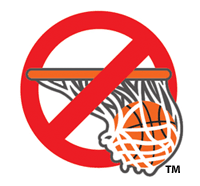
Continue and learn proven ways and techniques to defend the Hawk Offense
Return to Set Offenses - Click Here
Return to Offensive Strategies - Click Here
Return to HoopTactics - Click Here
© 2025 HoopTactics All Rights Reserved.
